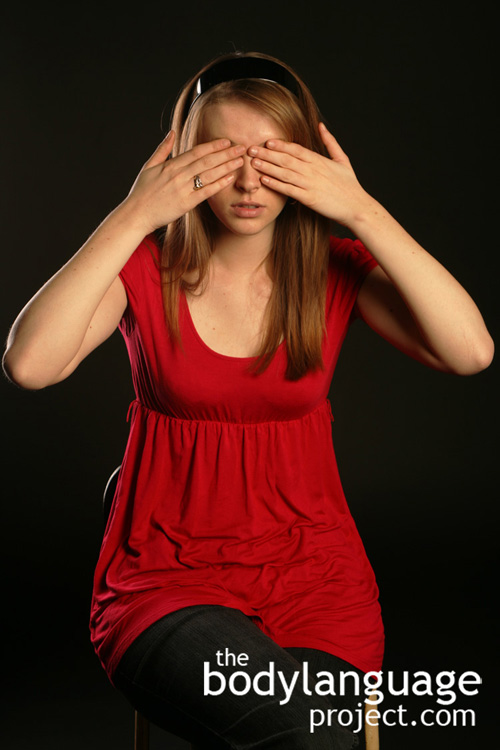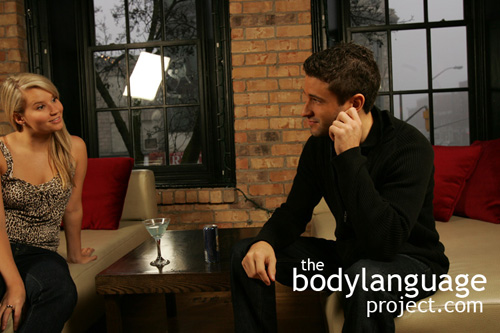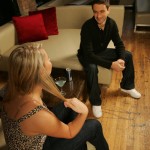The ear rub or pull is as gesture done as a response to greater blood flow to the ears and as a result of an increase in body temperature. Lying ear language can come in the form of a pull downward on the lobe, or as a scratch, or swipe behind the ear. When we get hot, we flush, and the neck and ears are particularly sensitive to flushing. Flushing is the body’s response to an overactive metabolism as it prepares to either fight, or take flight. When this cue is as a result of hearing a lie from someone else, or hearing something that is distasteful, it is done in an attempt to inhibit what a person is hearing by blocking the hears. Only it is not a complete blocking, but rather an abbreviated blocking so instead of covering them completely, the hand merely grazes the ears or pulls on them. Other times liars respond to the stress associated with lying themselves, so the ears are being touched to “block” the hears from hearing their own fib. When someone manages their body in this way, it tells us that they are having an inner battle with their self-image. In other words, this gesture is likely to appear only in those people that are traditionally honest. Pathological liars don’t hold a positive self image, at least not about their honesty and integrity, so feel no remorse from telling a lie and therefore go free of the stress response lying can sometimes produce.
Tag Archive for Ears
Increased Face-Touching
by Chris Site Author • March 6, 2013 • 0 Comments

Unnecessary face touching shows emotional discomfort. When in the right context, it can signal a lie.
Self touching is one thing we habitually associate with liars. They touch their chin, neck, nose, ears or will pull their collar away from their neck. These traits are of course related to nervousness and the mistake we sometimes make is directly associating nervousness with lying. As we have seen, not all liars are nervous. Let’s break this category down a little more.
Nervousness And Guilt In Lying
by Chris Site Author • March 6, 2013 • 0 Comments

“Talking out of the side of the mouth” came about because we feel that liars don’t speak to us straight; in plain terms.
One of the most reported cues of deception includes fear and nervousness. These include higher pitch, faster and louder speech, speech errors or stuttering and indirect speech or talking out of ‘the side of the mouth’ or in worse cases, the liar might even sound unpleasant. We might also see blushing of the face, neck or ears, an increase in blink rate, fidgeting, dilation of the pupils or sweating. In theory, the greater the apprehension of getting caught or the greater the stakes, the more evident these fear cues should be. As an increase in the possibility of punishment or with an increase in the severity of punishment we should also find an increase in nervous body language. The studies tell us that people who lie about something they’ve done wrong, termed a ‘transgression’, the more likely they were to show more deceptive cues presumably because they felt guilt more strongly.
We should also be cognoscente about the motivation of the liar. If they aren’t particularly vested in the lie, they might not show nervousness at all. Someone presenting a ‘white lie’ about who they were with the night previous, or their preference for chocolate versus vanilla ice cream, should be expected to show minimal nervousness. More experienced liars show very little nervousness, because, not only are they practiced at lying, they rarely get caught, so have little to worry about effectively destroying the hypothesis that nervousness specifically increases because of lying. Conversely, poor, but frequent liars, get caught so often that the consequences of their lies fail to bother them, so they also lack nervousness. We should also predict that lies told to close friends or family whom the liar cares for, should make them more susceptible to nervous body language. Here we might in fact see lower pitch, softer and slower speech and a downward gaze as they battle their consciousness. The stick in the spokes of this theory though is that sometimes telling the truth can causes guilt just the same as telling a lie, especially when it is known that the truth might hurt someone. Other times, telling the truth causes even more distress because of the shame of revealing possible shortcomings or mistakes to others. Thus, it’s a pretty safe statement to say that liars don’t always feel guilty about their lies and truth tellers don’t always feel good about their honesty. In fact, many liars justify their lies to prevent distress in other people!
Being unable or unwilling to embrace their lies is what makes lie tellers appear less truthful and convincing. So by this theory we should expect a liar to face more negative emotions when lying which truth tellers don’t face which in turn leads to at least faint feelings of discomfort which then leaks out through the body. However, again we find data to the contrary. It has been noted by researchers that liar can have less vested in their claims primarily because they haven’t actually occurred. This is counter what was presented thus far because instead of appearing more emotional, they may in fact appear less emotional. Lest we forget too that liars can present fearful emotions when they lie due to the chances of getting caught! If you haven’t gotten the point by now, you are starting to. The point is that emotions are intertwined with the fear of getting caught, anguish of lying and telling the truth and a myriad of other factors directly and indirectly related to lying.
As we know, when truth tellers speak, they are backed with an accumulation of knowledge, experience and wisdom from an event, whereas a liar is only acting out of his own imagination. This can provide clues to his deception. Therefore, the liar might offer fewer details, present their story with less emotional investment, provide less evidence to stake their claims, act less compellingly, appear less forthcoming, less pleasant and more tense. It is also important to note the motivation or context of the lie as well, as this will provide us with clues to watch for, be it nervousness, fear of getting caught and the guilt or the shame of either lying or not lying as the case may be.
The Ear Grabber
by Chris Site Author • March 6, 2013 • 0 Comments

When ear grabbing is done while listening to others speak it is due to disbelief, as in “I can’t believe what I’m hearing.”
The ear grab refers to a subconscious desire to “hear no evil” and is done by reaching up and pulling the ear in response to, either hearing something disagreeable, or saying something disagreeable. Children make no bones about blocking their ears when being teased or scolded by parents, but as we grow older, we drop the cue short because it is seen as juvenile, so instead we pull our ear, or earlobe. The gesture is an attempt at preventing the sounds from reaching a deeper part of the brain. It also sometimes represents anxiety and nervousness, and is classified as a defensive posture. We may see this gesture arise just as a performer is about to take the stage in front of thousands of people.
The ear grab can be use not only at the conclusion of the lies of others, but also at the conclusion of our own lies as well, and this is why it is referred to as a gesture that shows a desire to “hear no evil.” The gesture used at the conclusion of our own lies serves to reduce what is called “cognitive dissonance” which is the uncomfortable feeling that comes from holding two contradictory ideas simultaneously. For example, a used car salesman might talk about the quality of a certain car, than pull on his ear lobe, or more subtly, he might be found rubbing the edge of the ear, indicating that what he has just said is untrue. In this case, cognitive dissonance stems from the telling of a lie which is inherently bad, while a person feels that they are inherently good (it might seem odd, but everyone feels they are inherently good, even murders justify their actions). So lie tellers bridge their bad thoughts due to cognitive dissonance with the ear grab, until they have time to justify the lie to themselves. Therefore, it is the pain of the dissonance that causes the ear grab in liars.
When ear grabbing is done while listening to others speak it is due to disbelief as in “I can’t believe what I’m hearing” and the same “hearing no evil” is at play. In this case though, it is the receiver, not the sender, who wishes not to hear the lie. By touching or scratching the ears we hope that we can satisfy the nerve endings and end the discomfort. In other words, when we hear bad things, we go to our ears to try to turn the volume down. Other times, touching the ear means nothing at all and is simply the result of nervousness or boredom.
The ears often flush red when people are nervous which can be the case when they are worried about getting caught in a lie. This is why the ear grab and flushing, can be great poker tells when people are stressed about bluffing. The ear grab is a way that our bodies respond to the extra stimulation they get when agitated and we go to them to scratch or pull on them as stress relievers. Think of the ear grab like rubbing sore muscles or massaging a stiff back, except in this case the damage done is internal and it’s due to something that has been heard, which “hurts” the ears. Anytime someone shows the desire to touch their ear means that they are thinking about hearing, and it will be up to you to tie them to context and decide what it is they are really saying.
Sneering For You
by Chris Site Author • March 6, 2013 • 0 Comments

Sneering often happens as a microexpression, meaning it only briefly flashes quickly across the face before disappearing. It says “this smells fishy.”
Sneering says “I don’t care what you think, and I don’t respect you.” Because sneers happen as microexpressions, they often immediately following a stimulus. This makes it very easy to link the negative expression with its cause, serving to read the hidden thoughts.
Couples who sneer when listening to each other indicate that they lack respect and it has been shown that it is a good predictor for breaking up. Sneering can be done by employees who think they know more than their bosses, but whom resist speaking up because of fear of being fired, and by children who lack respect for authority. Wherever sneering shows it’s ugly face, it is due to distain.
Suckling And Mouthing Body Language
by Chris Site Author • March 6, 2013 • 0 Comments
The mouth and lips are full of nerve endings which, when stimulated, provides tactile gratification and comfort. However, anytime the fingers go to the mouth or play with the side of the mouth or lip, it’s a retrogressive action since the gesture is an attempt to regain the security they had as an infant suckling and mouthing. Nail biting is also a form of emotional body language, and when present, is usually habitual because of its origins. The habit which is highly unsightly screams “I am insecure” so should be eliminated from a person’s repertoire. These types of gestures are called “pacifying behaviours” because they are designed to reduce anxiety when exposed to something distressing. Pacifying language tells us the mind is not at ease and is an attempt to restore the body’ natural state. The ears, neck and nose are also areas people will hit when their minds require pacifying and they are covered next. Pacifying can also sometimes give up liars because they can be tied or linked to specific words uttered that then in turn require the body to be stroked to create comfort. Pacifying has everything to do with releasing bad tension as a substitute to the hand of a comforting mother.
While baby mouthing has no definitive explanation, it likely stems from the need to strengthen the muscles of the jaw and tongue and increase their coordination to better handle solid foods. Ancestral babies would not have had access to processed foods and the best they would have done was mouth to mouth transfers of masticated food, or food that was broken up by hand. These foods would have contained larger bits as well that might have caused less coordinated babies to choke. When babies first start eating solid foods, they need to balance the size and dryness of the foods with how much they need to mouth it, and yet it, so as to avoid moving it to the back of the throat too soon leading to gagging and vomiting. Poor mouth coordination tied with a mother who’s milk has gone dry too soon, and you have a baby facing early death. Mouthing, therefore, has a strong selective pressure, so today we find babies that mouth whatever they can, to get all the practice they can get. A secondary explanation to mouthing behaviour is that is serves as a way to test and explore objects with a sense that it more developed.
Hand to mouth actions are the most common target for auto touching. It might stem from the concern of giving up too much information, or letting a lie slip, or due to the need for reassurance. Covering the mouth is a natural reaction children do when they tell a secret or inadvertently say a word they know they shouldn’t. Speaking through the hand also shows insecurity and is found when uncomfortable people speak in public. They will hold an elbow on the table and wrap the forefinger around outside of the mouth as they speak.
Adults that are tense or anxious will play with their mouth or lip. Mouthing a pen, cigarette, piece of their own hair, and even gum when used as a comfort device, are a substitute for the mother’s breast and early childhood mouthing. Sucking, plucking, picking or chewing the lips, rubbing them with a finger or thumb are all forms of auto touching. Confident individuals would never consider using this type of security blanket, let alone be seen touching their faces out of insecurity.
The Invisible Lint Picker
by Chris Site Author • March 6, 2013 • 2 Comments

The invisible lint picker doesn’t like what’s being said and is trying to get out of the conversation.
Leaning forward and lowering the head shows a critical listener and indicates that what was being said is disliked. However, there is another related posture that shows an even greater form of contempt and disapproval. It happens also by dropping the head, however, while in the position, the person will begin to pluck invisible lint from their clothing. In doing so, eye contact is broken to stammer the flow of conversation. The gesture says that there are unspoken objections that are withheld either because they feel that they won’t be well received, because they are too timid to speak up, or is a passive attack on a figure of authority.
Any other rude gesture meant to occupy the mind in lieu of paying attention says that a person lacks respect, integrity or feels that they undeservedly lack control in the relationship and set out to prove it. A person can pick their nails or remove dirt from underneath them, drum their fingers, smooth their clothing when it does not require it, or seem distracted due to any number of factors. The goal of the invisible lint picker is to withhold eye contact to gain an upper hand and end the conversation on their terms, without being forthright about it. A person with integrity will use honest body language such as pointing their feet and torsos toward the doorway, reduce agreement indicators, and use conversation ending speech to speed things up. The lint picker, on the other hand, uses passive aggressive techniques to waste the speaker’s time with no regard for their own. At times the lint picker is trapped by a more authoritative figure than them, such as a boss, which prohibits them from leaving. Their defense to this is to figuratively “kick dirt in their eyes” by withdrawing from the conversation. When small children block their ears, close their eyes and sing to themselves loudly in order to tune out adults, they are accomplishing exactly what lint peckers have set out to do. Incidentally, small children also use distraction techniques to avoid the reprimands of adults. Whenever these cues persist they should be quickly rectified so as to maintain respect.
Undivided Attention
by Chris Site Author • March 6, 2013 • 0 Comments

An interested listener is focused on the entire person, their gestures, voice tone and the information delivered.
Meeting in crowded areas offers plenty of distractions, which in and of itself might lead one to belief that measuring attention would be difficult. However, the opposite is actually true; in other words, it’s easier to measure interest in busy places because the eye can be caught wondering. As we covered earlier in the chapter on eye language, we can verify interest based on where eyes are cast. The eyes tell where the body wants to be, and when the mind is fully engaged on the presentation, the focus will be on the speaker rather then what is going on around them.
Looking away rarely happens with someone who is completely engrossed in a conversation unless they do so to concentrate. We know from an earlier discussion, that faces are complicated making it difficult to process information. However absent of complex thought, we know that when someone looks away, it’s due to disinterest in the subject matter. Take for example, a very important news item appearing suddenly on television and the sequences of events that follow. First, we try to quiet a room so we have time to tune into the broadcast, next we locate the remote and turn the volume up loud enough so that even random noises don’t supersede the broadcast. Our eyes become fixated at the exclusion of anything else in the room and our ears become finely tuned to the voice of the broadcaster. When completely engaged, there is a fear of missing something important. This doesn’t just occur while watching television or movies, but can happen when in deep conversation, while reading something interesting or any other task for that matter. Any husband will tell you how easily it is to “tune” women out when watching sports!
An interested listener is focused on the entire person, their gestures, voice tone and the information delivered. For most, the picture they pick up about the speaker’s body language is subconscious, but it does help them form an overall impression of their honesty, integrity, emotionality and so forth. Therefore the focus doesn’t stop on the words alone, but on the entire message. An attentive listener is directed, having their bodies oriented toward the speaker, their arms open and apart willing to take information in, their legs will be crossed or open but aimed at the speaker, their head might be cocked to the side at forty five degrees showing interest, and any information they add will be appropriate to the given subject rather than off topic.
There will be times, when a fully attentive person will look away, down or about the room, but these ganders are few and brief, with the primary attention placed back on the speaker. It has been shown that up to eighty percent eye of contact is made while listening and about forty to sixty percent while speaking. Thus, we can measure the level of interest simply by making note of how often the person looks away. Someone that is bored will almost seem to look everywhere but at the speaker, or will appear to glaze over in an unblinking stare. Looking away is a subconscious indication that the other person is looking for an escape route – a way out of the conversation.
The Most Common Types Of Smiles
by Chris Site Author • March 5, 2013 • 0 Comments
The following is a comprehensive list, with accompanying description, outlining the various smiles you might encounter.
______________________________________________________________________________________________
ONE. The tight lipped smile with low intensity. This smile happens as the lips are stretched across the face and no teeth are showing. The tight lipped smile can vary with intensity as well, and it is directly related to the amount the lips are raise in the corners of the mouth. The low intensity smile has very little upward curl in the corner of the mouth and indicates a hidden attitude or thought, uncertainty, hesitation or lack of confidence. In this smile the lips are stretched toward the ears with no curl using muscles called the risorius. The risorius muscles are unable to raise the corner of the lips. Small babies have been shown to use this smile for all others except their mothers whom they reserve the use of the true smile. This smile is used to placate others or to pose for photographs when we aren’t in the mood. Strangers passing on the street might also use this shallow smile as a form of greeting or acknowledgement. The smile is a feigned or dishonest smile so that others don’t catch on that we actually don’t like them. It might also appear out of nervousness or stressed, so it can appear when meeting new people. For this reason we can call the tight lipped smile the “polite smile.” When the tight lipped smile with low intensity happens in conversation in can serve to negate the previous statement. For example, a man might say about his boss “He’s a great boss, I’d switch companies and follow him anywhere if he left.” and this might be followed by a tight lipped smile serving to negate the comment.
______________________________________________________________________________________________
TWO. Tight lipped smile with high intensity. This is a variation on the smile above, yet the corners of the lips rise even further with some teeth showing. The lips are slightly separated, the corners of the mouth are upturned, gaze is steady and warm and the posture is relaxed. We find this smile appearing when meeting new acquaintances, so it’s not a full honest smile, but does show openness to others. The tight lipped smile with high intensity is more appropriate for acquaintances because a full smile is reserved for our friends and family and would only come off as insincere with new company. A full smile around new people would lead them to think “What’s that guy’s problem, he’s grinning like we were the best of friends, yet we just met.”
______________________________________________________________________________________________
THREE. The uneven smile. We might see this smile associated with tongue-in-cheek humour or sarcasm. The smile happens when only one side of the face sports a smile and the other side does not. The opposite side may even be down turned or frowning. The uneven smile depicts a frame of mind in which opposite emotions are present. The uneven smile would accompany cheeky humour amongst friends and would crack to show others that sarcasm was intended. We rarely see this expression aside from in the West, since sarcasm is much less common around the world.
______________________________________________________________________________________________
FOUR. The upper smile. In this smile, the upper lid is raised to expose only the top row of teeth, but the true significance is that the lower teeth remain hidden. In the upper smile the jaw and teeth remain closed and the message conveyed is of medium pleasure and comes off as insecure. Used car salesman, who beam light from their teeth in this way, will seem to have a hidden agenda.
______________________________________________________________________________________________
FIVE. The grin or smirk. The smirk indicates smugness and arrogance. It is a tight lipped smile with the addition of a degree self satisfaction for good measure. A nervous smile often appears like a smirk but they are not to be confused. The smirk has accompanying dominant body language such as head back, shoulders back, open postures along with dialogue riddle with exuberant pride. The smirk will happen too when someone is under direct verbal attack. It’s the sort of face that makes you want to say “Wipe that grin off your face”. Sometimes though the smirk is due to the stress of being put under fire and isn’t always an attempt at questioning authority.
______________________________________________________________________________________________
SIX. Broad smile. In this smile the upper and lower teeth are made visible. The gaze is relaxed and the smile is intended to convey joy and pleasure. This is a true smile and not one that is easily faked. The tell tale sign of an honest smile, is the appearance of crow’s feet in the corners of the eyes. Crow feet make it seem as though the eyes are smiling. It is difficult to replicate these smiles without being truly amused or in good company as the muscles are usually out of our conscious control. We should be careful to use this smile, as with all smiles, when most appropriate, as in the wrong context will simply appear insincere.
______________________________________________________________________________________________
SEVEN. Down-turned smile or reverse smile. Happens when the mouth is inverted into a down-facing “u” shape. It indicates high stress, unhappiness, anger, tension and depression.
______________________________________________________________________________________________
Above: Paul Ekman talks briefly about types of smiles.
Eye Blocking
by Chris Site Author • March 5, 2013 • 1 Comment

A childlike response to fearful stimuli is to block the eyes from seeing. Adults will use more subtle forms of eye blocking such as squinting.
Eye squinting or covering can be related back to a baseline to produce predictive powers. For example, while questioning someone about theft or vandalism, or any other event that brings back images that someone wishes not to recall, note when eyes become constricted. This will tell you which aspects of your recount makes them most uncomfortable. When vital information is struck, eye blocking in one form or another will surface. From there, it will be up to you to deduce the exact reason for eye blocking. Squinting can also flash as a microexpression in accompaniment of inconsistent body language to reveal true feelings. For example, smiling and waving to an acquaintance at a distance while squinting, shows that there is a poor connection and perhaps a subsurface distaste for them. Squinting can also be done while reading material that is disagreeable and will arise instantaneously without awareness. This is obviously a very useful ‘tell’ when negotiating contracts or devising plans. Other times eyebrows will lower instead of eye squinting, but the meaning is the same. Conversely, raised or arched eyebrows show positive feelings and high confidence.












